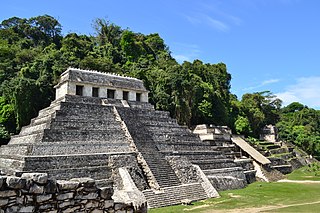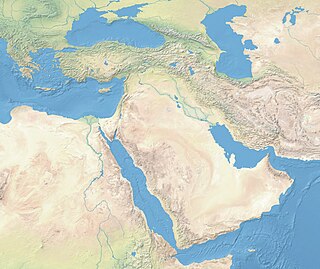
Biological anthropology, also known as physical anthropology, is a scientific discipline concerned with the biological and behavioral aspects of human beings, their extinct hominin ancestors, and related non-human primates, particularly from an evolutionary perspective. This subfield of anthropology systematically studies human beings from a biological perspective.

Palenque, also anciently known in the Itza Language as Lakamhaʼ, was a Maya city state in southern Mexico that perished in the 8th century. The Palenque ruins date from ca. 226 BC to ca. 799 AD. After its decline, it was overgrown by the jungle of cedar, mahogany, and sapodilla trees, but has since been excavated and restored. It is located near the Usumacinta River in the Mexican state of Chiapas, about 130 km south of Ciudad del Carmen, 150 meters (490 ft) above sea level. It averages a humid 26°C (79°F) with roughly 2,160 millimeters (85 in) of rain a year.

Kʼinich Janaab Pakal I, also known as Pacal or Pacal the Great, was ajaw of the Maya city-state of Palenque in the Late Classic period of pre-Columbian Mesoamerican chronology. He acceded to the throne in July 615 and ruled until his death. Pakal reigned 68 years—the fifth-longest verified regnal period of any sovereign monarch in history, the longest in world history for more than a millennium, and still the longest of any residing monarch in the history of the Americas. During his reign, Pakal was responsible for the construction or extension of some of Palenque's most notable surviving inscriptions and monumental architecture. Pakal is perhaps best known in popular culture for his depiction on the carved lid of his sarcophagus, which has become the subject of pseudoarchaeological speculations.
Osteology is the scientific study of bones, practised by osteologists. A subdiscipline of anatomy, anthropology, and paleontology, osteology is the detailed study of the structure of bones, skeletal elements, teeth, microbone morphology, function, disease, pathology, the process of ossification, and the resistance and hardness of bones (biophysics).
The term bioarchaeology has been attributed to British archaeologist Grahame Clark who, in 1972, defined it as the study of animal and human bones from archaeological sites. Redefined in 1977 by Jane Buikstra, bioarchaeology in the United States now refers to the scientific study of human remains from archaeological sites, a discipline known in other countries as osteoarchaeology, osteology or palaeo-osteology. Compared to bioarchaeology, osteoarchaeology is the scientific study that solely focus on the human skeleton. The human skeleton is used to tell us about health, lifestyle, diet, mortality and physique of the past. Furthermore, palaeo-osteology is simple the study of ancient bones.

Paleopathology, also spelled palaeopathology, is the study of ancient diseases and injuries in organisms through the examination of fossils, mummified tissue, skeletal remains, and analysis of coprolites. Specific sources in the study of ancient human diseases may include early documents, illustrations from early books, painting and sculpture from the past. Looking at the individual roots of the word "Paleopathology" can give a basic definition of what it encompasses. "Paleo-" refers to "ancient, early, prehistoric, primitive, fossil." The suffix "-pathology" comes from the Latin pathologia meaning "study of disease." Through the analysis of the aforementioned things, information on the evolution of diseases as well as how past civilizations treated conditions are both valuable byproducts. Studies have historically focused on humans, but there is no evidence that humans are more prone to pathologies than any other animal.
The Robert J. Terry Anatomical Skeletal Collection is a collection of some 1,728 human skeletons held by the Department of Anthropology of the National Museum of Natural History of the Smithsonian Institution, Washington, D.C., United States.

The Temple of the Inscriptions is the largest Mesoamerican stepped pyramid structure at the pre-Columbian Maya civilization site of Palenque, located in the modern-day state of Chiapas, Mexico. The structure was specifically built as the funerary monument for K'inich Janaab' Pakal, ajaw or ruler of Palenque in the 7th century, whose reign over the polity lasted almost 70 years. Construction of this monument commenced in the last decade of his life, and was completed by his son and successor K'inich Kan B'alam II. Within Palenque, the Temple of the Inscriptions is located in an area known as the Temple of the Inscriptions’ Court and stands at a right angle to the Southeast of the Palace. The Temple of the Inscriptions has been significant in the study of the ancient Maya, owing to the extraordinary sample of hieroglyphic text found on the Inscription Tablets, the impressive sculptural panels on the piers of the building, and the finds inside the tomb of Pakal.
George R. Milner is an American archaeologist in the Department of Anthropology at The Pennsylvania State University. He has done archaeological research on sites encompassing a range of time periods in Illinois, Missouri, Wisconsin, and Kentucky, and has also worked in Egypt and Saipan (Micronesia). He has worked with prehistoric and historic human skeletal remains from eastern North America, Denmark, and Egypt. By using modern samples of known age from the United States, Switzerland, and Portugal, he has helped refine skeletal age estimation techniques.
George J. Armelagos was an American anthropologist, and Goodrich C. White Professor of Anthropology at Emory University in Atlanta, Georgia. Armelagos significantly impacted the field of physical anthropology and biological anthropology. His work has provided invaluable contributions to the theoretical and methodological understanding human disease, diet and human variation within an evolutionary context. Relevant topics include epidemiology, paleopathology, paleodemography, bioarchaeology, evolutionary medicine, and the social interpretations of race, among others.
Charlotte Ann Roberts, FBA is a British archaeologist, academic and former nurse. She is a bioarchaeologist and palaeopathologist, whose research focuses on health and the evolution of infectious disease in humans. From 2004 to 2020, she was Professor of Archaeology at Durham University: she is now professor emeritus.

Medieval Bioarchaeology is the study of human remains recovered from medieval archaeological sites. Bioarchaeology aims to understand populations through the analysis of human skeletal remains and this application of bioarchaeology specifically aims to understand medieval populations. There is an interest in the Medieval Period when it comes to bioarchaeology, because of how differently people lived back then as opposed to now, in regards to not only their everyday life, but during times of war and famine as well. The biology and behavior of those that lived in the Medieval Period can be analyzed by understanding their health and lifestyle choices.
Osteoware is a free data recording software for human skeletal material that is managed through the Smithsonian Museum of Natural History. It is used by biological anthropologists to document data relevant to research and forensic applications of human skeletal remains in a standardized and consistent way. It has influenced other skeletal recording software, and has been successfully used at the Smithsonian for collecting data relevant to biological anthropology. Osteoware is the only free, individual-use software for the collection of data on skeletal material in anthropology.
Clark Spencer Larsen is an American biological anthropologist, author, and educator. His work focuses on bioarchaeology, the study of human remains from archaeological settings. Although his interests span the entire record of human evolution, his research largely pertains to the last 10,000 years, a period of dynamic change in health, well-being, and lifestyle, much of which relates to population increase, overcrowding, and nutritional decline that co-occurred with the transition from hunting and gathering to agriculture, creating living conditions that humans are grappling with to the present day.

Kristina Killgrove is an American bioarchaeologist, science communicator, and author who primarily covers anthropology and archaeology news and engages in research on ancient Roman skeletons. She is a regular contributor to Live Science and previously to Mental Floss,Science Uncovered, and Forbes. From 2012 to 2018, she was faculty in anthropology at the University of West Florida and she has maintained an affiliation as a research scholar at the Ronin Institute since 2011. She is currently affiliated with the University of North Carolina at Chapel Hill.
Vera Tiesler is a bioarchaeologist, and a full research professor in the department of Anthroprological Sciences at the Autonomous University of Yucatán in Mexico. She is a specialist in Maya civilization remains.
Rebecca Gowland is a bioarchaeologist. She is a Professor of Archaeology at Durham University.

Near Eastern bioarchaeology covers the study of human skeletal remains from archaeological sites in Cyprus, Egypt, Levantine coast, Jordan, Turkey, Iran, Saudi Arabia, Qatar, Kuwait, Bahrain, United Arab Emirates, Oman, and Yemen.
The Old royal family of Copán was the dynasty that ruled the city-state of Copan before the foundation of the Yax Kuk Mo dynasty in 426 AD. The ancient royal family of Copan has been under an aura of mystery due to the scant information we have about it, meaning that its existence is known thanks to archeological remains.








